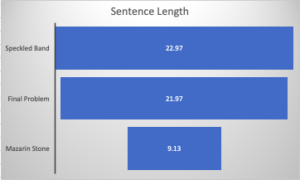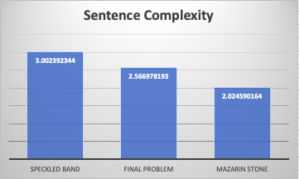Data and Analysis
During the Victorian Era, sensation novels became very popular as reading became less of a wealthy privilege and started to be a past time for common people. The usage of periodicals and monthly installments of articles, satiric essays, and fiction spread literature to masses of people like never before. Sensation novels were considered stories that showed intense display of emotions, usually dealing with crime or secret lives as an outcome of domestic problems such as adultery in a proper setting as seen in the Victorian Era. As reading became a past time for the people of this time, authors and their characters started to gain fame like never seen before. Sherlock Holmes was one of the characters that gained large popularity and created such an affect that he is still around in modern storytelling and media today.
Sherlock Holmes is a fictional character that has completely occupied the minds and imaginations of its audience for over 125 years now. Holmes has been one of, if not the most well-known detective character ever created. However, Doyle was not planning on this occurring and did not see himself as an author of crime stories and started to gain a disdain against the detective character he created. Doyle was more interested in his other works, mostly his historical essays and thought of Sherlock as concealing his other work. Sherlock Holmes appears in 62 cases, although after only 25 of these stories, Doyle wrote in his diary about how he was worried that the character was distracting him from more serious work and decided to kill him off. Although, the death of Sherlock Holmes caused an outrage by fans and 20,000 readers of The Strand Magazine cancelled their subscription of the magazine due to the death of their favorite character. After 8 years and a lot of hate mail, Doyle finally resurrected Sherlock Holmes and wrote 34 more stories about his cases. But how did his creator’s lack of interest in the genre of literature affect the stories he appeared in?
In order to answer the question of how Doyle’s contempt of his character Sherlock affected his literature we ran a few of his short stories through computer programs. By comparing Doyle’s work seen in one of most well regarded Sherlock stories in “The Adventure of the Speckled Band”, with the story in which he attempted to kill off the character to focus on other work in “The Final Problem”, and one of his stories after resurrecting the character in “The Adventure of the Mazarin Stone” we attempted to use the programs to show potential difference of effort in the creation of the Sherlock Holmes short stories by Conan Doyle.
We looked at three main elements in the short stories:
- Length of the story
- Sentence Length
- Sentence Complexity

Figure one shows a chart in which the word count of each story is shown in comparison to the others in terms of size, as well as the numerical amount. As seen in Figure 1, the story “The Adventure of the Speckled Band” which was published in February of 1892, was the longest of the three stories analyzed, having a word count of 9,601. “The Final Problem” which was released in December of 1893, was the story in which Doyle attempted to kill off Sherlock, had a word count of 7,052. And the final story we analyzed “The Adventure of the Mazarin Stone”, which was released much later in October of 1921 had the lowest word count of stories we analyzed with 5,568 words.
Sir Arthur Conan Doyle regarded “The Adventure of the Speckled Band” as his favorite Sherlock Holmes story he ever wrote, and it is apparent in the length of his story. “The Final Problem” was number four on his list of his favorite Sherlock stories and the length of the story was not far off of his personal favorite. In contrast, one of his stories that were released after Doyle was pressured into bringing back the character in “The Adventure of Mazarin Stone” showed a much shorter story, being around 42% of the length of his personal favorite story written. When trying to answer if Conan Doyle’s dislike of his character overshadowing his other work had an affect on the effort put into his short stories, the sentence length of these stories tells a similar story.

Figure two shows the average sentence length seen in each of the short stories we analyzed. The average length of the sentence seen in each short story tells an interesting story. Doyle’s favorite, had almost 23 words per sentence in “The Speckled Band” and a similar sentence length was seen in “The Final Problem” with almost 22 words per sentence. In contrast, “The Adventure of the Mazarin Stone” only featured about 9 words in each sentence. While it is hard to come to a conclusion about the effort put into a piece of literature, the smaller word count and much shorter sentence length seen in “The Adventure of the Mazarin Stone” is something that can help prove that Doyle’s dislike of this character had an affect on his writing of the short stories.

Finally, we looked at the sentence complexity of each short story. The program calculates sentence complexity based how many punctuation marks appear in each sentence. As seen in Figure three, “The Adventure of the Mazarin Stone” finished with the least complex sentence structure having an average of about 2 punctuation marks per sentence, while “The Adventure of the Speckled Band” had the most complex sentences with just over 3 punctuation marks per sentence. “The Final Problem” landed right in the middle with about 2 and a half punctuation marks in each sentence. While the 3 texts didn’t have a very large difference in their results for sentence complexity, it is an important tool to look at because of its implications along with the other analysis we conducted.
Sherlock Holmes’ popularity obscuring Doyle’s other work and his disdain toward the character because of it is something that is rarely seen by creators. Doyle’s public dislike of creating Sherlock Holmes stories is very interesting because of how popular it is among his fans and how long the character has stayed relevant in story telling. It is hard to conclude if Doyle’s effort in creation of the stories was lesser because of his dislike of the character after analyzing the word count, sentence length, and sentence complexity of just 3 of his 62 cases. However, through our analysis, it is clear that there is a major difference in the structure of the “The Adventure of the Mazarin Stone”. The length of the story was shorter than the other two texts by quite a good margin, and the sentence length of the story was far shorter than two of his favorite stories. Even his sentence complexity dipped in that story and is evidence that there is a difference in the writing of Sherlock Holmes stories after the resurrection of Doyle’s most written character.